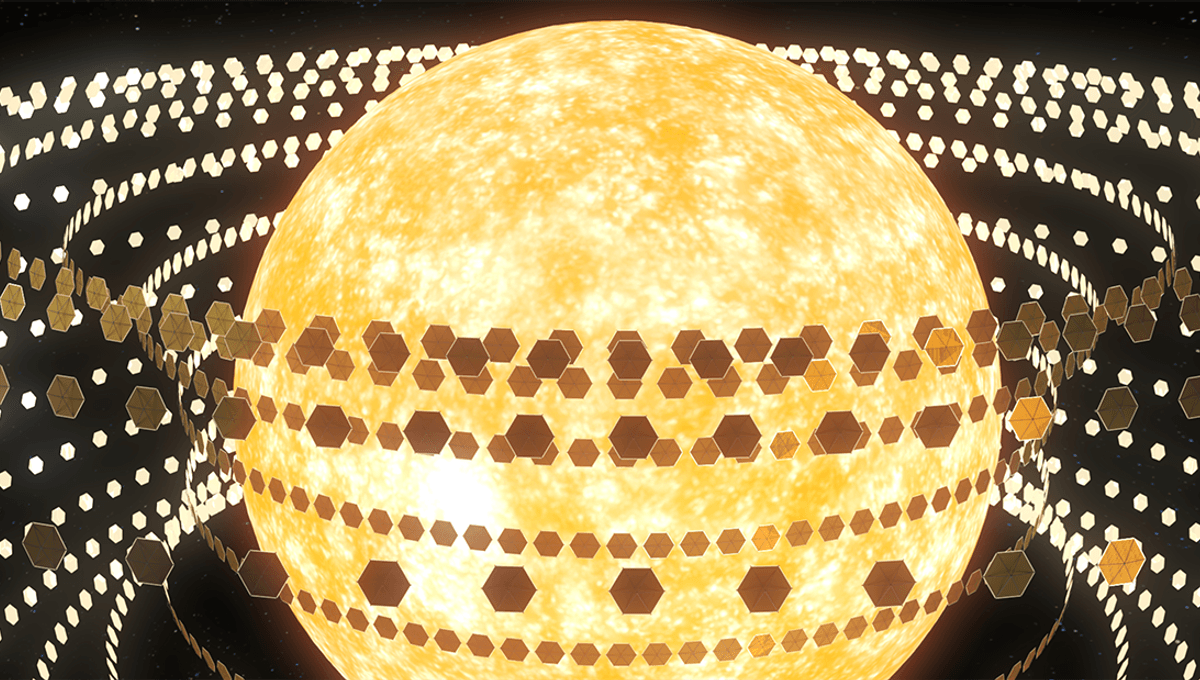New Study Raises "Disturbing Prospect" About Alien Civilizations Using Dyson Swarms

New Study Raises "Disturbing Prospect" About Alien Civilizations Using Dyson Swarms
A new study has taken a look at how plausible the idea of "Dyson swarms" is, how long they could feasibly be maintained by an advanced civilization, and whether it would be possible for us to detect them. As well as finding that they may be plausibly detectable around certain star types, the author suggests a "disturbing prospect" for any other potential lifeforms in their vicinity.
In our hunt for technologically advanced alien civilizations out there in the universe, it is useful to think about what sort of signs of life we ourselves give off, such as radio signals and biosignatures. It's perfectly logical to do so, but it's not altogether ideal. As we've seen over the last few hundred years on our own planet, intelligent civilizations can quickly abandon old detectable technology as their understanding of the universe increases. For this reason, it's also useful to look at what might be possible for ourselves to build in the future. Alien civilizations will have access to the same physics as we do, so if we can imagine projects that are plausible but beyond our current technology, there's a chance that alien civilizations have beaten us to it. One such possibility is a "Dyson sphere" – a megastructure built around a star to harness all or most of its energy. Though a full sphere built around a star would quickly become unstable, Dyson swarms (many smaller structures that do not form a full sphere) have been deemed more plausible, and could offer any energy-hungry civilization a healthy supply of the good stuff with which they could power other ridiculous projects of their choosing. Though we have looked for potential Dyson spheres and other signs of advanced alien civilizations, they have all (where explanations have been found) turned out to be natural phenomena, for example, hot DOGs. In a new paper, Brian C Lacki, a theoretical astronomer with the Breakthrough Listen Initiative, looked at the possibility of spotting such a structure. The problem, according to Lacki, is that we are separated from potential other civilizations not just by the vast distances of space, but by the eons of time. Any structure that we might have a chance of spotting would need to last for a reasonable astronomical timescale if we are going to actually spot it. "Even if every single star is home to intelligent life at some point during its lifespan," Lacki explains, "the odds are against us observing them unless the lifespan of the technosignatures is many millions of years." So the question is, how long could a Dyson swarm feasibly continue to orbit a star and harvest energy, given what we know of the laws of physics? Could they outlast the civilization that put it there? According to Lacki, that might be somewhat wishful thinking. "Herein lies a major threat to megastructure lifespans: if abandoned, the individual elements eventually start crashing into each other at high speeds," Lacki writes, adding that the collision would spray out pieces of debris over the solar system. "Each of these pieces is itself moving at high speeds, so that even pieces much smaller than the original elements can destroy them. Thus, each collision can produce hundreds of missiles, resulting in a rapid growth of the potentially dangerous population and accelerating the rate of collisions. The result is a collisional cascade, where the swarm elements are smashed into fragments that are in turn smashed into smaller pieces, and so on, until the entire structure has been reduced to dust." Dyson swarms are pretty hypothetical, and we do not know what the best method of creating them would be, nor exactly where we should position them around a star. Modeling it so that the swarm is placed at random throughout the solar system – an unlikely configuration – the resulting cascade could be swift, depending on the host star. Around a Sun-like star, the megaswarm would be reduced to dust in around 41,000 years, a tiny amount of time in an astronomical context. K-dwarfs would host a Dyson swarm for around 1,000 years, while M-dwarfs would not even allow the swarm to orbit once before the whole thing turns into space trash. White dwarfs – the stellar remnants our Sun will eventually evolve into – could only host a swarm for 0.00018 years. However, stars with larger radii would be more favorable. Red giants were found to cascade after 5.3 × 109 years, while red supergiants cascaded after 8.4 × 1013 years. Lacki suggests that aliens could make a more stable megastructure by placing it in close orbit, positioned like a ring around their star, though this too would still need to be maintained to function and avoid cascade. Nevertheless, they may still need to move inner planets, and then planets further out as the swarm grows, in order to maintain the swarm. "This raises a disturbing prospect—a Kardashev Type III metasociety may annihilate planetary systems as it expands to stabilize their megaswarms, leaving everything within its 'bubble' barren of planets. If those megaswarms then are destroyed anyway, no planets will remain on which to restart life," the paper explains. "Furthermore, in most early-type galaxies, there will be no star formation to ever replace them. Thus, the megaswarms portend doom, and leave behind a permanently sterilized galaxy in their wake." Maybe we don't want to detect one after all. The study is published in The Astrophysical Journal.


